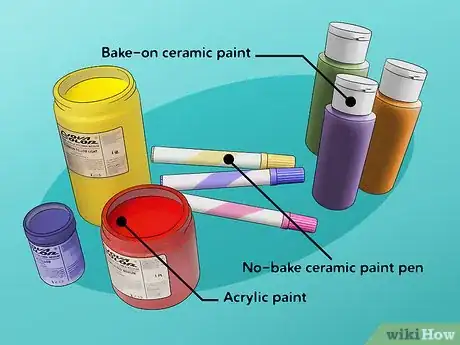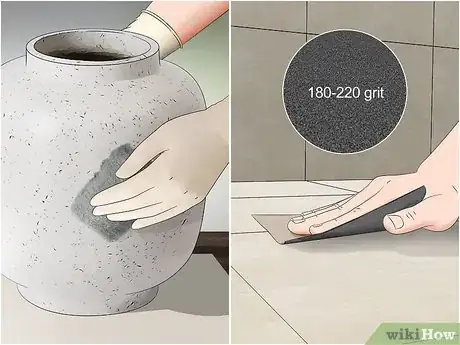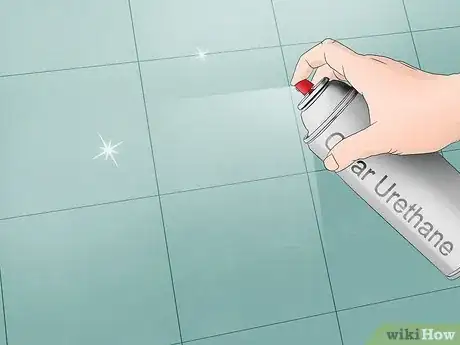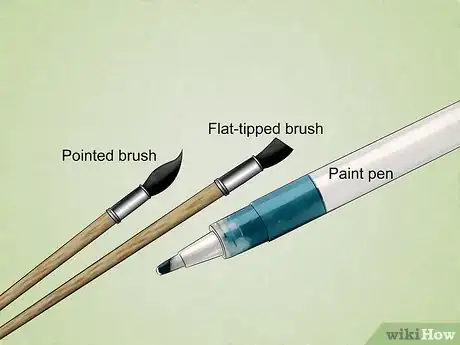This article was co-authored by Natasha Dikareva, MFA. Natasha Dikareva is a San Francisco, California based sculptor, and installation artist. With over 25 years of ceramics, sculpting, and installation experience, Natasha also teaches a ceramic sculpture workshop titled "Adventures in Clay" covering concept development, hand-building techniques, texture, and glazing techniques. Her work has been featured in solo and group exhibitions at the Beatrice Wood Center for the Arts, Abrams Claghorn Gallery, Bloomington Center for the Arts, Maria Kravetz Gallery, and the American Museum of Ceramic Art. She has taught at the University of Minnesota and the American Indian OIC School. She has been awarded the Excellence Award at the 1st World Teapot Competition, Best in Show at the 4th Clay & Glass Biennial Competition, and a Grand Prize at the American Museum of Ceramic Art. Natasha holds an MFA from the University of Minnesota and a BFA from Kiev Fine Arts College.
There are 13 references cited in this article, which can be found at the bottom of the page.
This article has been viewed 675,059 times.
Painting ceramic items is a fun and inexpensive way to refresh old home décor or create a personalized gift or centerpiece. The process for painting ceramic tile and ceramic dishes or pottery is generally the same with a few slight variations due to the size of the projects. You can apply paint to ceramic by hand or with spray paint, and you can add fun details with paint brushes and pens. When you’re sanding and painting ceramic, always work in a well-ventilated area for safety.
Steps
Painting by Hand
-
1Pick latex, acrylic, or epoxy paint for ceramic tile or large pieces of pottery. For projects like painting a tile wall or a ceramic vase, use a liquid paint that you can apply by hand. Opt for epoxy paint to get a glossy, highly durable and long-lasting finish. Alternatively, acrylic and latex paint aren’t as durable for high-traffic areas as epoxy, but are easier to find and work with.[1] [2]
- Keep in mind that epoxy is more expensive than most other kinds of paint.
Tip: Latex paint is best for areas where you won’t be walking since the finish is softer and more easily scratched and scuffed.
-
2Clean the ceramic thoroughly with water and cleaner. For ceramic tile, thoroughly scrub the area you plan to repaint with an abrasive cleaner, and wipe it down until it's clean and dry. For pieces of pottery and dishes, simply wipe down the surface of the item with a wet rag until it’s clean of dirt and debris.[3]
- Alternatively, you can also use a clean sponge to gently scrub off any caked-on dirt or stains.
Advertisement -
3Sand the surface of the ceramic to remove any glossy coating. For dishes and pottery, sand lightly by hand with a piece of steel wool. For ceramic tile, affix 180 or 220-grit sandpaper to an orbital sander and sand your tiles down carefully. Be sure to wipe up any dust with a wet rag after sanding.[4]
- The sandpaper creates microabrasions in the glaze of the dish or tile, allowing paint to stick more easily.
- You should also sand the ceramic if the surface is uneven, since that could affect the finish of the paint.[5]
- Your goal is to remove any extra gloss remaining above the ceramic itself, without damaging the ceramic.
-
4Apply 2 light coats of primer to the ceramic. Use a spray or oil-based liquid bonding primer for the tile, and coat it with light, even layers. Let each layer dry in between painting coats to ensure that the paint will stick. If the primer looks gritty after 2 or 3 coats, lightly sand the surface with a piece of steel wool. Let the primer dry for 12-24 hours before continuing with the project.[6] [7]
Tip: If you’re painting tile on the walls of a shower, look for a special primer that’s formulated for wet areas, such as an epoxy primer.
-
5Paint small areas of the ceramic at a time with a zigzag pattern. Dip a roller or paint brush into the paint and dab it on a piece of cardboard or a tray to remove excess paint. Move the brush or roller in diagonal lines in small sections to coat the ceramic. Once one section is coated, move to the area to paint diagonally until the surface of the ceramic is covered.[8]
Note: Remember to let the paint dry according to the directions on the packaging.
-
6Sand the ceramic lightly after the first coat is dry. Once the paint is dry, use a 220-grit sandpaper to lightly sand the paint. Hold the sandpaper in your hand, and focus on areas where you have ridges or drips from the paint. If you’re sanding a piece of pottery or a dish, opt for a piece of steel wool instead.[9]
Tip: Make sure the first coat is completely dry before you begin sanding. If the paint is still wet, you can smear it with the sandpaper.
-
7Add a second coat of paint, finishing with long, vertical strokes. Apply the paint in small sections using a roller in a zigzag pattern. Once the tile is coated, add a final coat in vertical lines from the top to the bottom of the ceramic. This will provide an even, smooth finish for the paint.[10]
Note: You can use this method to paint both tile and pieces of ceramic pottery. It provides even coverage that is durable and visually appealing.
-
8Let painted ceramic dry for 2-3 days before using it. If you’ve painted a ceramic tile wall, updated ceramic flooring, or refinished a piece of pottery, let the paint dry completely before touching the ceramic. While it may feel dry to the touch after just a day, leave it dry for an additional 24-48 hours to ensure that it is cured.[11]
Tip: You should also wait for 2-3 days after applying a clear coat or sealant to the ceramic to ensure that it's cured.
-
9Apply clear urethane or epoxy to ceramic tile for a glossy finish. For an easy and inexpensive finish, apply urethane in 2 coats, waiting for each coat to dry completely. For a more durable but expensive finish, apply 1-2 coats of clear epoxy to the tile.[12]
- You can apply an epoxy finish over acrylic or latex paint to make it more durable and water-resistant.
Spray Painting Ceramic
-
1Choose a spray paint for a quick and easy finish. For glossy and previously painted pieces of ceramic, opt for a ceramic or plastic-safe spray paint, which contain compounds that fuse to smooth surfaces. Use glossy spray paint for projects with more surface area where you want easy, even coverage with a minimal amount of work.[13]
-
2Apply 1-2 light coats of spray primer. If the ceramic isn’t already white, choose a ceramic-safe primer. Shake the can for 15-30 seconds before spraying the surface of the ceramic with a light coat. Then, let the coat dry for 2-3 hours, and then apply an additional coating of primer for more coverage.[14]
Note: If the primer has a gritty texture to it when it dries, lightly sand the paint with a piece of steel wool to remove ridges and bumps.
-
3Spray 3-4 light coats of paint onto the primed ceramic. Apply the paint in zigzag lines all over the item, including the top, front, and sides. After you finish applying a coat, let the paint dry until it’s slightly tacky, which should take about 15-30 minutes. Then, apply an additional 1-3 coats of paint until it is completely coated.[15]
Tip: With glossy paint, you may be able to achieve an even coverage within 2 coats, depending on which shade you’re painting the item.
-
4Let the paint dry according to the directions. Place the painted item in a well-ventilated area to dry for 30 minutes to 1 hour. When you think the paint is dry, lightly touch an inconspicuous spot, like the back or bottom of the item, to ensure that the paint is completely cured.[16]
Note: If you live in a hot or humid area, it may take up to 2 hours for the paint to dry completely. Be patient and try not to touch it until it’s mostly dry!
Creating Designs and Patterns
-
1Add fine details, like vines and flowers, with small brushes. To paint flower buds or leaves, use a pointed brush to apply a tiny blob of paint to the dish where the base of the bud or leaf will be. Then, drag and lift the brush in the direction of the tip of the bud or leaf.[17]
A flat-tipped brush is ideal for geometric work such as rims and straight lines, as well as for filling in larger areas of paint. If you plan to stencil in a design, a small flat-tipped brush is also probably the best choice.
-
2Write and doodle designs with an acrylic or oil-based paint pen. Wipe down your ceramic object with a damp towel and then dry it with a clean towel. Then, use the markers to draw patterns, write phrases, or create drawings. When you’re happy with the artwork, bake the object in the oven at 375 °F (191 °C) for 40 minutes.[18]
Tip: If your paint pen isn't writing, hold the pen against a piece of paper or cardboard so the tip is pressed down. Then, shake the pen to move the paint down onto the tip.
-
3Use painter's tape to paint stripes on tiles, dishes, and bowls. Add the painter’s tape in even lines, and then use a small brush to apply ceramic paint in between the paint strips. Let the paint dry for 5-10 minutes, and then remove the tape before the paint is completely dry. Bake the item in the oven according to the package directions.[19]
Note: If you’re painting a plate, mug, or bowl, be sure to use food-safe paint.
-
4Paint over a stencil on ceramic tile to create a dynamic and eye-catching pattern. To make a ceramic tile wall or floor more interesting, tape a stencil with a fun pattern on it to the tile. Then, brush or roll paint over the stencil, and carefully lift the stencil to reveal the design. If you’re covering a large area, position the stencil on the next tile to create a repeated design.[20]
Tip: If you’re painting over glossy or sealed ceramic, be sure to sand the area thoroughly with an orbital sander before applying your paint with the stencil. If you sand the area, you should paint over it with a solid color to achieve an even finish before stenciling.
-
5Bake dishes that have been hand painted with ceramic paint. If you chose to paint a dish with a paint pen or acrylic paint for ceramics, set it aside to dry for 24 hours. Then, bake it in an oven according to the manufacturer's instructions. Be sure to turn off the oven after the specified time, and let the item cool completely before removing it.[21]
- Always follow the manufacturer's instructions for curing the paint. The paint that you use may need to cure for a longer period or at a high temperature.
Tip: If you don’t have the directions for your ceramic paint, place the piece of pottery in an unheated oven. Then, turn the heat on to 350 °F (177 °C) and let the ceramic heat up for 30 minutes before removing it from the oven.
Expert Q&A
-
QuestionCan you use oil-based paint on ceramics?
 Natasha Dikareva, MFANatasha Dikareva is a San Francisco, California based sculptor, and installation artist. With over 25 years of ceramics, sculpting, and installation experience, Natasha also teaches a ceramic sculpture workshop titled "Adventures in Clay" covering concept development, hand-building techniques, texture, and glazing techniques. Her work has been featured in solo and group exhibitions at the Beatrice Wood Center for the Arts, Abrams Claghorn Gallery, Bloomington Center for the Arts, Maria Kravetz Gallery, and the American Museum of Ceramic Art. She has taught at the University of Minnesota and the American Indian OIC School. She has been awarded the Excellence Award at the 1st World Teapot Competition, Best in Show at the 4th Clay & Glass Biennial Competition, and a Grand Prize at the American Museum of Ceramic Art. Natasha holds an MFA from the University of Minnesota and a BFA from Kiev Fine Arts College.
Natasha Dikareva, MFANatasha Dikareva is a San Francisco, California based sculptor, and installation artist. With over 25 years of ceramics, sculpting, and installation experience, Natasha also teaches a ceramic sculpture workshop titled "Adventures in Clay" covering concept development, hand-building techniques, texture, and glazing techniques. Her work has been featured in solo and group exhibitions at the Beatrice Wood Center for the Arts, Abrams Claghorn Gallery, Bloomington Center for the Arts, Maria Kravetz Gallery, and the American Museum of Ceramic Art. She has taught at the University of Minnesota and the American Indian OIC School. She has been awarded the Excellence Award at the 1st World Teapot Competition, Best in Show at the 4th Clay & Glass Biennial Competition, and a Grand Prize at the American Museum of Ceramic Art. Natasha holds an MFA from the University of Minnesota and a BFA from Kiev Fine Arts College.
Ceramics & Sculpting Instructor Yes—it dries slower than a paint like acrylic, but it is possible to paint ceramic with oil paints.
Yes—it dries slower than a paint like acrylic, but it is possible to paint ceramic with oil paints. -
QuestionCan ceramic tiles be baked to cure acrylic paint?
 Community AnswerAcrylic paint doesn't need to be baked, it will burn or melt. Just let it sit and dry completely.
Community AnswerAcrylic paint doesn't need to be baked, it will burn or melt. Just let it sit and dry completely. -
QuestionHow do I repair a broken ceramic flower pot?
 Community AnswerUse strong glue, such as epoxy glue, which bonds better on heavy objects and smooth surfaces like ceramics.
Community AnswerUse strong glue, such as epoxy glue, which bonds better on heavy objects and smooth surfaces like ceramics.
Warnings
- Be sure to work in a well-ventilated area, or set up fans to ventilate the area where you’re working as much as possible. Dust, mold, and paint fumes can cause respiratory issues if you breathe them in.⧼thumbs_response⧽
References
- ↑ Natasha Dikareva, MFA. Ceramics & Sculpting Instructor. Expert Interview. 1 June 2021.
- ↑ https://www.todayshomeowner.com/how-to-paint-over-ceramic-tile-in-a-bathroom/
- ↑ https://www.todayshomeowner.com/how-to-paint-over-ceramic-tile-in-a-bathroom/
- ↑ https://www.todayshomeowner.com/how-to-paint-over-ceramic-tile-in-a-bathroom/
- ↑ Natasha Dikareva, MFA. Ceramics & Sculpting Instructor. Expert Interview. 1 June 2021.
- ↑ https://www.apartmenttherapy.com/how-to-diy-paint-ceramic-tile-68877
- ↑ https://www.todayshomeowner.com/how-to-paint-over-ceramic-tile-in-a-bathroom/
- ↑ https://youtu.be/IjcYo_YA8Zo?t=209
- ↑ https://youtu.be/IjcYo_YA8Zo?t=238
- ↑ https://youtu.be/IjcYo_YA8Zo?t=249
- ↑ https://www.apartmenttherapy.com/how-to-diy-paint-ceramic-tile-68877
- ↑ https://www.apartmenttherapy.com/how-to-diy-paint-ceramic-tile-68877
- ↑ https://www.triedandtrueblog.com/how-to-spray-paint-ceramic/
- ↑ http://www.dimplesandtangles.com/2013/03/how-to-paint-ceramics.html
- ↑ http://www.dimplesandtangles.com/2013/03/how-to-paint-ceramics.html
- ↑ https://www.triedandtrueblog.com/how-to-spray-paint-ceramic/
- ↑ https://youtu.be/7F5FKH-t9Ec?t=43
- ↑ https://abeautifulmess.com/2015/12/try-this-food-safe-and-dishwasher-safe-mug-tutorial.html
- ↑ https://thecraftedlife.com/how-to-paint-ceramic/
- ↑ http://thediymommy.com/how-to-paint-tile-floors-with-a-stencil/
- ↑ https://youtu.be/DlCtqzV42UU?t=335
About This Article
To paint ceramic by hand, clean the ceramic surface with water and cleaner. If the surface of the ceramic is glossy, lightly sand the area with steel wool or very fine sandpaper. Then, apply 2 coats of primer to the ceramic. Once the primer is dry, apply 2 coats of latex, epoxy, or acrylic paint to the ceramic, sanding lightly over the dry paint in between coats. Let the paint dry for 2-3 days, and then apply a varnish if you want a glossy finish. Keep reading to learn how to spray paint on ceramic!








































































